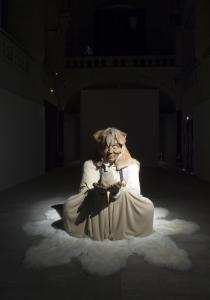Ritter/Zamet is pleased to present the first exhibition in the UK of French artist Virginie Barré. Already well-established in her native France, Barré has been included in important group exhibitions including the recent Notre Histoire: an emerging French art scene at the Palais de Tokyo, Paris (2006), the Lyon Biennial, the Museé d’art modern de la Ville de Paris, the Louisiana Museum of Modern Art in Copenhagen (2005), The Museé des beaux-arts, Bordeaux (2004) and the Prague Biennial (2003).
Virginie Barré’s intention is to search out and expose hidden polarities and oppositions from a wide-ranging repertoire of appropriated pop culture paraphernalia and imagery. With her singular sculptural creations and room filling, site-specific visual environments, Barré establishes a compelling world of quirky characters that contradict and subjugate their original purpose with intoxicating effect.
Past installations have seen rotund and red-faced superheroes crouching on walls or suspended uncomfortably on cables, sinister-looking children skulking in corners wearing wigs and Halloween masks, and the fallen victims of bizarre make-believe murders lying prostrate in pools of blood amidst the strewn evidence of the preceding mêlée. At the same time, phoney comic-style narratives or frames culled from cinematic classics such as Antonioni’s Blow Up, or Kubrick’s The Shining are translated into graphic, colour-by-numbers renditions. At each turn, Barré strips our cultural clichés of their easy access resonance, turning the melodrama against itself as a tool for satire, sensation and a good deal of humour.
For her show at Ritter/Zamet, Barré has shifted her attention to aligning the seemingly disparate subject matter of Bauhaus with that of the Native American Indian. Although it is always her intention to playfully jam one image reference against another just to see what happens, it cannot be ignored that there is a potent, if unlikely, connecting subtext between the two. One only has to compare the teachings of Bauhaus painter Paul Klee to “follow the ways of natural creation, the becoming, the functioning of forms”, with the basis of Native American philosophy to live in balance with ourselves, with each other and the environment.
In the centre of the gallery, a giant-sized Indian figure sits cross-legged with eyes closed and arms outstretched as she contemplates her own blindfolded effigy. While this stands as a clear symbol of the artist’s self-reflective relationship with her own work—from sculptor to sculpture—Barré also plays with every cinematic Cowboys-and-Indians cliché in the book, from the swathed animal skins to the deeply creased skin of the wise and aged Indian Shaman in a state of trancelike, transcendent meditation.
The surrounding large scale works on paper refine these timeworn formulae further as a group of fierce-looking Indian warriors clasp feather-adorned spears, yet instead of being located out in the American Wild West, they stand on top of the flat roof of a house designed by Hungarian architect Farkas Molnar from 1923. Elsewhere, the Indians invade famous photographs of Bauhaus architecture and furniture, raising teepees behind Marcel Breuer’s Wassilly chair, conducting sacred rituals within Marcel Breuer and Gustav Hassenpflug’s gymnasium and fishing in Joseph Hartwing’s 1922 chess set.
Virginie Barré’s intention is to search out and expose hidden polarities and oppositions from a wide-ranging repertoire of appropriated pop culture paraphernalia and imagery. With her singular sculptural creations and room filling, site-specific visual environments, Barré establishes a compelling world of quirky characters that contradict and subjugate their original purpose with intoxicating effect.
Past installations have seen rotund and red-faced superheroes crouching on walls or suspended uncomfortably on cables, sinister-looking children skulking in corners wearing wigs and Halloween masks, and the fallen victims of bizarre make-believe murders lying prostrate in pools of blood amidst the strewn evidence of the preceding mêlée. At the same time, phoney comic-style narratives or frames culled from cinematic classics such as Antonioni’s Blow Up, or Kubrick’s The Shining are translated into graphic, colour-by-numbers renditions. At each turn, Barré strips our cultural clichés of their easy access resonance, turning the melodrama against itself as a tool for satire, sensation and a good deal of humour.
For her show at Ritter/Zamet, Barré has shifted her attention to aligning the seemingly disparate subject matter of Bauhaus with that of the Native American Indian. Although it is always her intention to playfully jam one image reference against another just to see what happens, it cannot be ignored that there is a potent, if unlikely, connecting subtext between the two. One only has to compare the teachings of Bauhaus painter Paul Klee to “follow the ways of natural creation, the becoming, the functioning of forms”, with the basis of Native American philosophy to live in balance with ourselves, with each other and the environment.
In the centre of the gallery, a giant-sized Indian figure sits cross-legged with eyes closed and arms outstretched as she contemplates her own blindfolded effigy. While this stands as a clear symbol of the artist’s self-reflective relationship with her own work—from sculptor to sculpture—Barré also plays with every cinematic Cowboys-and-Indians cliché in the book, from the swathed animal skins to the deeply creased skin of the wise and aged Indian Shaman in a state of trancelike, transcendent meditation.
The surrounding large scale works on paper refine these timeworn formulae further as a group of fierce-looking Indian warriors clasp feather-adorned spears, yet instead of being located out in the American Wild West, they stand on top of the flat roof of a house designed by Hungarian architect Farkas Molnar from 1923. Elsewhere, the Indians invade famous photographs of Bauhaus architecture and furniture, raising teepees behind Marcel Breuer’s Wassilly chair, conducting sacred rituals within Marcel Breuer and Gustav Hassenpflug’s gymnasium and fishing in Joseph Hartwing’s 1922 chess set.
